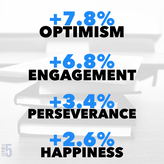|
My previous post ("Well-Being Defined") covered the components that make up adult well-being: Positive Emotion, Engagement, Relationships, Meaning, and Accomplishment.
While these are applicable to all people, there is a way to better connect these concepts with our students from a developmental standpoint. Some awesome people from the University of Pennsylvania and Temple University (Margaret L. Kern, Lisbeth Benson, Elizabeth A. Steinberg, and Laurence Steinberg) created a way to measure the well-being of adolescents. Instead of PERMA, the acronym EPOCH is used: Engagement, Perseverance, Optimism, Connectedness, Happiness. I mentioned EPOCH in a recent post, but I thought it would be helpful to go into more detail. While some of the definitions are similar to PERMA, there are some subtle differences and additions. The 5 Building Blocks of Student Well-Being: EPOCH Engagement Engagement is basically the same as the adult definition of Engagement. It is being so completely absorbed in an activity that you lose track of time--you are in flow. Perseverance Perseverance could also be called “grit.” It is the ability to keep going when you face adversity. Perseverance means you set goals, go after them despite the challenges you face, and stick to it even if it takes awhile. Optimism Optimism is having both hope and confidence about the future. In general, you view things in a favorable way and when negative events happen, you see them as only temporary. Connectedness Connectedness deals with relationships and feeling close to others. It involves feeling loved, supported, and valued by people in your life. Happiness Happiness is a general feeling of joy, cheer, and contentment with life. It is important to note that you may not feel happy every moment, but you generally feel content with life. Can You Measure EPOCH? Thanks to the survey created by Kern, Benson, the Steinbergs, we can definitely measure student well-being based on EPOCH. The 20-question survey asks participants to rank varying personal descriptions based on 5 categories ranging from “not like me” to “very much like me.” Each EPOCH building block is related to 4 questions (see picture). How I Used the Survey I administered the survey without much explanation to get a baseline of my students. I then started implementing a couple of strategies to enhance well-being: “What Went Well” & “Gratitudes.” (These are explained in an earlier blog post). After 25 days, we took the survey again to see growth. You can learn more about my study here: https://www.duanejourdeans.com/blog/can-teachers-actually-increase-student-well-being-in-just-a-couple-minutes-a-day-yes
0 Comments
What do I love most about positive psychology? It’s proactive. Positive psychology studies people who are flourishing, discovers why, and share strategies that can be implemented to move lives further on the positive spectrum.
When I first started studying positive psychology, I thought everything revolved around one topic: positivity. As I learned more, I discovered that it all revolved around the ideas of well-being--it was a lot broader than just being positive or having a positive mindset. Positivity is important, but it is not the whole story--it is a piece of the story. Dr. Martin Seligman created the acronym PERMA to share the 5 major components of well-being: Positive Emotion, Engagement, Relationships, Meaning, and Accomplishment. As administrators and educators, we can not only improve ourselves, but we can help our students flourish as well. Initially, it is important to identify and define each component of PERMA: (P) Positive Emotion This component deals with feelings like happiness, cheerfulness, joy, gratitude, and optimism. When I begin each of my classes, I try to nudge my students towards these positive emotions. When these emotions are activated, students will be more engaged and the learning centers of their brain will be activated. Studies have shown that much of the level of our positive emotion is heritable, but there are ways to raise these levels by about 15% which can have a large impact. The What Went Well exercise I mentioned in an earlier post is an example of a proven way to grow positive emotion. (E) Engagement Engagement can be described as being in “flow,” where a person actually loses track of time because they are so immersed in a task. Dr. Seligman describes it as “being one with the music.” Research has shown that flow occurs when your highest strengths match your current challenge. In essence, it is important that we know our strengths...and it is important that our students are aware of their strengths. Once we understand, we can put them to use and heighten our level of engagement. In addition, we can use our signature strengths to work through difficult situations. (R) Relationships The positive and healthy relationships we have are integral to our well-being. We are a connected species; the people we spend our time with have a direct impact on our ability to flourish in life. Being connected to others is not a natural skill for everyone, but there are strategies that can help us form and sustain positive relationships. (M) Meaning Human beings inherently search for meaning or purpose in life. Meaning occurs when you belong to, and serve something, bigger than the self. (A) Accomplishment/Achievement Accomplishment is pretty straightforward, but working through a task to the end is very rewarding. Characteristics like grit and self-discipline are highly linked to this category. As educators, we should work to draw out, grow, and celebrate each PERMA component in ourselves and our students. If we do, a fulfilling life will follow. Can Teachers Actually Increase Student Well-Being in Just a Couple Minutes a Day? [...Yes!]7/30/2020  During the 2019-2020 school year (before COVID 19 smacked us in the face) I decided to up my game a bit more regarding positive psychology in education, so I conducted a study in my classroom. I had been implementing a number of positive priming techniques at the beginning of classes, but I wasn’t really measuring anything to gauge impact or level of success. I decided to create a 25-day study and really measure some things. Who were the subjects? I collected data from 56 high school students ranging from 9th to 12th grade. We didn’t use any names. I gave each student a random “secret number” that was assigned to their assessments. I didn’t know who had what number; I could only see the trend within each student number. They just had to write their number somewhere so they could put it on their assessments (and yes, a couple of students forgot their number after the first assessment, so we had to do some problem-solving). What did they do? First, I gave them a baseline test to assess their level of well-being. It is based on concepts created by Margaret L. Kern, Lisbeth Benson, Elizabeth A. Steinberg, and Laurence Steinberg of the University of Pennsylvania and Temple University. The assessment is intended to measure the students’ well-being regarding 5 categories:
What were the results? After the 25 days were completed, students took the EPOCH assessment again. All 5 areas increased, but some more than others.
I was very pleased with the outcome after just 25 days, and I immediately began to think about how I could modify things to impact the categories that had smaller gains. Would I do anything differently? I continue to learn more and more pretty much every day. Here are a couple of the tweaks I would make to make things even more impactful:
What did the students say? A vast majority of students really enjoyed the daily activities. It became part of their routine, but one that made them feel good. Many students commented on how they were starting to notice things throughout the day that they could write down the next day. They were beginning to change the way their brain was viewing and scanning the world. There were also students that said it seemed like it was positively impacting their extracurriculars--they felt more focused and calm during competition. In essence, the students enjoyed the experience and felt it positively impacted them even beyond the classroom. *Click here to see the official PDF describing the EPOCH categories. **If you are interested in the survey I used, or have any questions, just shoot me an email at duanejourdeans@gmail.com. I finally tried out the video creation software Doodly to share some strategies about overcoming procrastination. (I think I was delaying my use of it). Recent studies show that about 70% of college students claim they struggle with procrastination on a regular basis. I think the age groups below and above have similar issues. I know I do! In the video I share 6 techniques that may help. The one that really clicks for me is #1: The 5 Minute Take-Off. I struggle with perfectionism, so sometimes I freeze up rather than start. The 5 Minute Take-Off gets me to just get going. Once I do, I typically get into flow. It is so amazing how a small technique--a small shift in mindset--can help so much. Here are the 6 Strategies: 1. The 5 Minute Take-Off 2. Reward Yourself 3. Go Public 4. Use the Team Approach 5. Write It Down 6. Be Sure to Recover Take a look at the video, try out some of the strategies, and let me know what works for you in the comments. (...it can help teachers, too)I’m hoping this post can give you a better understanding of Positive Priming: both what it is and how to implement it. However, I know it is not all-inclusive, so if you have any questions, please email me at duanejourdeans@gmail.com. During these crazy COVID times, I think it is also important to mention that Positive Priming can also be done virtually!
The Reality This is the challenge: as humans, we are wired to scan for the negative...for threats. So we are inherently constantly scanning our environment for what can kill us--or maybe harm us not just physically, but emotionally. This means we are really good at finding the negative. To overcome this overwhelming magnetic pull, we need to put in work to change what we focus on. Positive Priming can help. Where Did Positive Priming Come From? I think I coined the term Positive Priming around 2016 or so. I had been using the strategy for a number of years before, but I officially named it only a few years ago. However, the whole idea of the benefit of positive emotions came from North Carolina years before. Dr. Barbara Fredrickson of UNC is one of the world’s leading researchers of positivity--in fact, one of her books is titled Positivity. Within, Fredrickson shares a concept called the Positivity Ratio. Basically, if a person has a ratio of about 3 positive emotions to every 1 negative emotion, they will flourish...they will be pretty successful. Over time, there has been some debate about the ratio being 5 to 1, but I think we can all agree that anywhere between 3 and 5 will be just fine for what I’m discussing here. This concept is what led me to start thinking about Positive Priming. If I could help my students have a better positivity ratio, they might be more successful. So I researched more. Fredrickson identified 10 major positive emotions that were most impactful: joy, gratitude, serenity, interest, hope, pride, amusement, inspiration, awe, and love. My focus was to attempt to ignite one or more of these emotions in my students within the first few minutes of class each day. What Can Positive Priming Actually Do For Your Students? The scientifically-proven benefits of Positive Priming are many. Here are some of my favorites:
The Basics of Positive Priming
A Sample Week of Positive Priming I will say that I don’t usually follow a pattern each week anymore. I try to use some variety from day-to-day, but I do use WOW Wednesdays and Thank You Thursdays almost every week. In addition, each day I give students a small bit of time to talk about the priming activity. It is usually just like 30 seconds, but it could be more depending on how it resonates. At any rate, here is what a week of priming could look like:
And There's a Bonus! Here is the beauty of this entire post: Yes!--Positive Priming will work for your students, but...wait for it...it will work for teachers, too. In essence, if you engage in priming activities, you will reap the benefits as well. Enjoy the videos. Laugh. Write down 3 new things you are grateful for. Do as much as you can. You don’t have to do every activity every class period, but even if you choose one hour a day to engage, you will put yourself in a positive state...and it will help bring out the best in yourself and your students. P.S. In my Positive Charge workshop, I help participants collaborate and actually create multiple days of potential Positive Priming activities! A number of years ago, I discovered positive psychology. After researching for just a month or so, I decided I would try to apply some concepts in my high school classroom. Specifically, I was interested in how positivity could affect student performance (in terms of grade %), so I created something I call "Positive Priming."
Basically, "Positive Priming" is intentionally trying to activate positive emotions in students at the beginning of class. It can take as little as 10 seconds, but most of my positive priming activities are around 2 minutes. (I'll create a separate post about the details of positive priming in the future, but for now, I'll just share that I simply wanted to put students in a positive state.) From a research-based standpoint, being in a positive state as opposed to a negative or neutral state enhances multiple things including engagement, creativity, and ability to learn new concepts/strategies/techniques. I had 5 freshman English classes at the time, so I devised a plan to implement 3 different strategies and assess impact. During first quarter, there was to be "Positive Priming" to establish a baseline. Then, during second quarter, the following Priming Plan would be administered:
After looking at the year-long results, I became curious if it affected any other measurable factors in my students--behavior came to mind beyond grade percentage. My classroom rarely has any behavior issues, but on occasion, I do have to report things to the office. I'd say maybe once or twice a quarter I have had to at least notify the office or document some type of negative behavior. During first and second quarter, I had a few instances involving mild inappropriate behavior. Second semester...zero. In fact, reported negative behavior was much lower in the 9th grade during second semester in all classes. Was it related to the "Positive Priming" and social connection in my class? Maybe...maybe not. But specifically in my class, performance was up and negative behavior was down. Sounds like a great combo to me! |

 RSS Feed
RSS Feed
